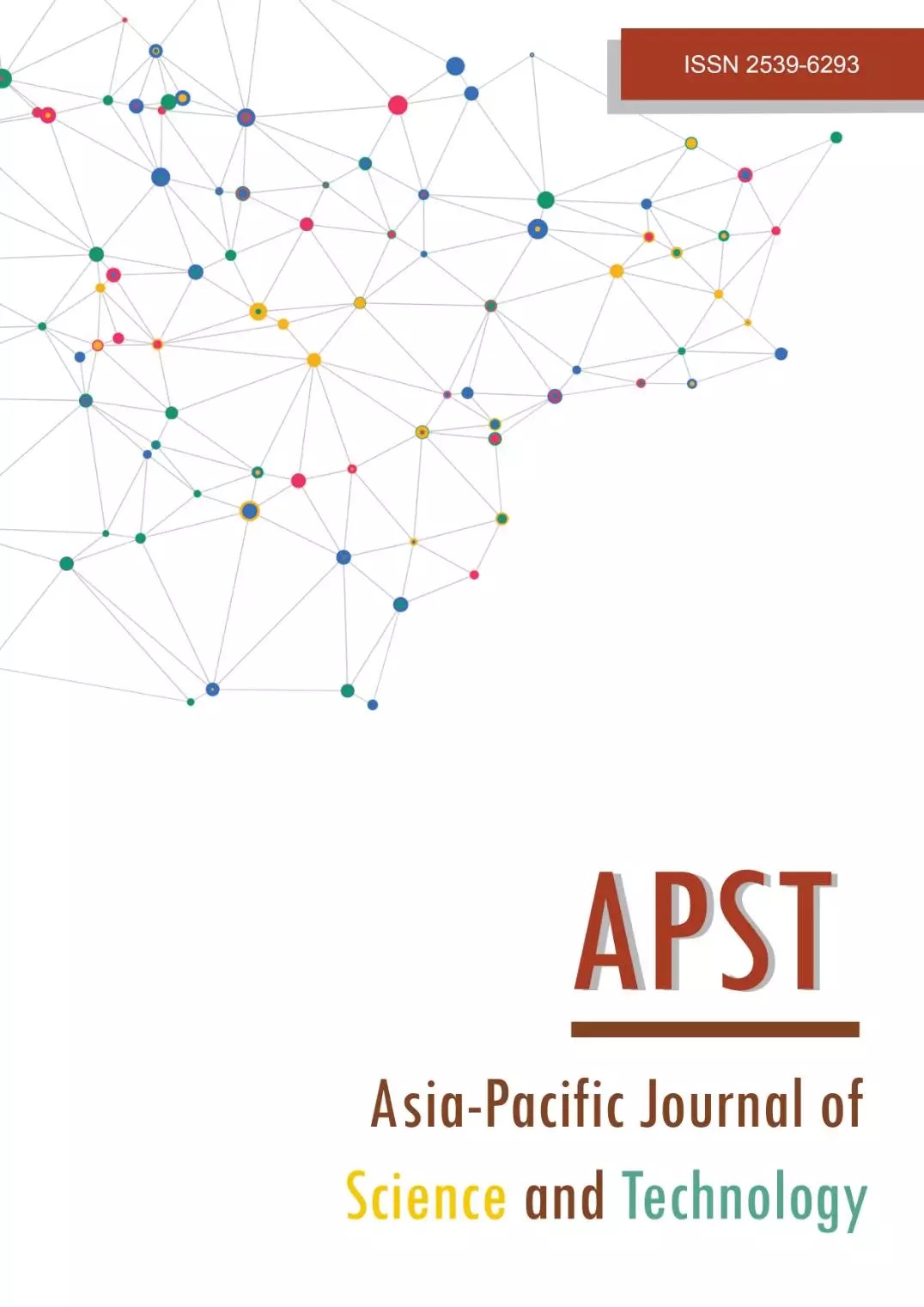Formulation of herbal concealer containing fennel seed oil and lavender oil with anti-Propionibacterium acnes activity
Main Article Content
Abstract
Acne is one of the most prevalent dermatologic diseases worldwide. Several substances derived from the herb are currently utilized to treat acne. Interestingly, incorporating essential oils with anti-Propionibacterium (P) acnes activity into concealer may help manage acne as well as conceal skin flaws. The study aimed to formulate a concealer with anti-acne properties, using Thai herbal oil with anti-P. acnes activities, and determine the formulation's stability. The anti-microbial activity against P. acnes DMST 14916 of fennel seed oil (FSO) and lavender oil (LO), and mixtures of the two was evaluated using agar disc diffusion and microbroth dilution assays. Concealers containing oils that have effective anti-P. acnes activity were formulated and tested for stability under the determined storage conditions. The result showed that FSO and LO in the ratio of 50:50 exhibited the highest inhibition against P. acnes of 23.39±0.48 mm of the inhibition zone with a minimum inhibitory concentration value of 1.56 mg/L. A silicone-based concealer incorporating 0.2% of these blended oils was formulated. F7 provided good texture, spreadability and coverage properties among the seven formulations, and had a pleasant odour. This formulation was biologically, chemically, and physically stable under the determined stability testing storage. In conclusion, a silicone-based anti-acne concealer containing blended oils of FSO and LO (50:50) was successfully developed. This formulation (F7) may be utilized both to manage acne and conceal skin imperfections problems using the benefits of herbal preparations.
Article Details

This work is licensed under a Creative Commons Attribution-NonCommercial-NoDerivatives 4.0 International License.
References
Halvorsen JA, Stern RS, Dalgard F, Thoresen M, Bjertness E, Lien L. Suicidal ideation, mental health problems, and social impairment are increased in adolescents with acne: a population-based study. J Invest Dermatol. 2011;131:363-370.
Yadav S, Gupta M. Formulation and evaluation of anti-acne herbal face wash gel. J Drug Deliv Ther. 2019;9:523-525.
Mate A, Ade P, Pise A, More S, Pise S, Kharwade R. Formulation and evaluation of polyherbal gel for the management of acne. Int J Cur Res Rev. 2021;13:117-122.
Fried R, Friedman A. Psychosocial sequelae related to acne: looking beyond the physical. J Drugs Dermatol. 2010;9:s50-s52.
Kapoor S, Saraf S. Topical herbal therapies an alternative and complementary choice to combat acne. Res J Med Plant. 2011;5:650-669.
Daud FS, Wankhede S, Joshi M, Pande G. Development of herbal anti-acne gel and its evaluation against acne-causing bacteria Propionibacterium acnes and Staphylococcus epidermidis. Int J Res Ayurveda Pharm. 2013;4:781-786.
Zaenglein AL, Pathy AL, Schlosser BJ, Alikhan A, Baldwin HE, Berson DS, et al. Guidelines of care for the management of acne vulgaris. J Am Acad Dermatol. 2016;74:945-973.
Kumar A, Baboota S, Agarwal S, Ali J, Ahuja A. Treatment of acne with special emphasis on herbal remedies. Expert Rev Dermatol. 2008;3:111-122.
Khunawattanakul W, Caichompoo W, Mekjaraskul C, Charoenmit A, Lekdee C, Srichan, N. Anti-propionibacterium acnes from Thai herbal medicines. J Sci Technol MSU. 2017:607-613.
Sayorwan W, Siripornpanich V, Piriyapunyaporn T, Hongratanaworakit T, Kotchabhakdi N, Ruangrungsi N. The effects of lavender oil inhalation on emotional states, autonomic nervous system, and brain electrical activity. J Med Assoc Thai. 2012;95(4):598-606.
Prasad SB. Acne vulgaris: a review on pathophysiology and treatment. Asian J Pharm Clin Res. 2016;9:54-59.
Balouiri M, Sadiki M, Ibnsouda SK. Methods for in vitro evaluating antimicrobial activity: a review. J Pharm Anal. 2016;6:71-79.
Diao W, Hu Q, Zhang H, Xu J. Chemical composition, antibacterial activity and mechanism of action of essential oil from seeds of fennel (Foeniculum vulgare Mill.). Food Control. 2014;35:109-116.
Bagherani N, Smoller BR. Role of tea tree oil in treatment of acne. Dermatol Ther. 2015;28:404.
Weber N, Biehler K, Schwabe K, Haarhaus B, Quirin KW, Frank U, et al. Hop extract acts as an antioxidant with antimicrobial effects against Propionibacterium acnes and Staphylococcus aureus. Molecules. 2019;24:223.
Wahba HE, Ibrahim ME, Mohamed MA. Comparative studies of the constituents of fennel essential oils extracted from leaves and seeds with those extracted from waste plants after harvest. J Mater Environ Sci. 2018;9:2174-2179.
Saharkhiz M, Tarakemeh A. Essential oil content and composition of fennel (Foeniculum vulgare L.) fruits at different stages of development. J Essent Oil-Bear Plants. 2011;14:605-609.
Kwiatkowski P, Pruss A, Masiuk H, Polanowska M, Kaczmarek M, Kalemba GS, et al. The effect of fennel essential oil and trans-anethole on antibacterial activity of mupirocin against Staphylococcus aureus isolated from asymptomatic carriers. Postepy Dermatol Alergol. 2019;36:308-314.
Leong W, Lai K, Lim SE. Combination therapy involving Lavandula angustifolia and its derivatives in exhibiting antimicrobial properties and combatting antimicrobial resistance: current challenges and future prospects. Processes. 2021;9:609.
Puvača N, Milenković J, Coghill GT, Bursić V, Petrović A, Tanasković S, et al. Antimicrobial activity of selected essential oils against selected pathogenic bacteria: in vitro study. Antibiotics. 2021;10:546.
Hou HS, Bonku EM, Zhai R, Zeng R, Hou YL, Yang ZH, et al. Extraction of essential oil from Citrus reticulate blanco peel and its antibacterial activity against Cutibacterium acnes (formerly Propionibacterium acnes). Heliyon. 2019;5:e02947.
Zu Y, Yu H, Liang L, Fu Y, Efferth T, Liu X, et al. Activities of ten essential oils towards Propionibacterium acnes and PC-3, A-549 and MCF-7 cancer cells. Molecules. 2010;15:3200-3210.
Orchard A, Vuuren SF, Viljoen A, Kamatou G. The in vitro antimicrobial evaluation of commercial essential oils and their combinations against acne. Int J Cosmet Sci. 2018;40:226-243.
Kivrak S. Essential oil composition and antioxidant activities of eight cultivars of Lavender and Lavandin from western Anatolia. Ind Crops Prod. 2018;117:88-96.
Lee CJ, Chen LW, Chen LG, Chang T, Huang C, Huang M, et al. Correlations of the components of tea tree oil with its antibacterial effects and skin irritation. J Food Drug Anal. 2013;21:169-176.


